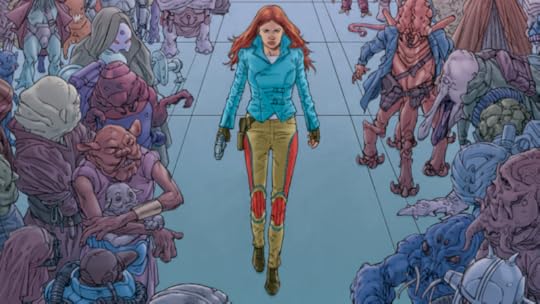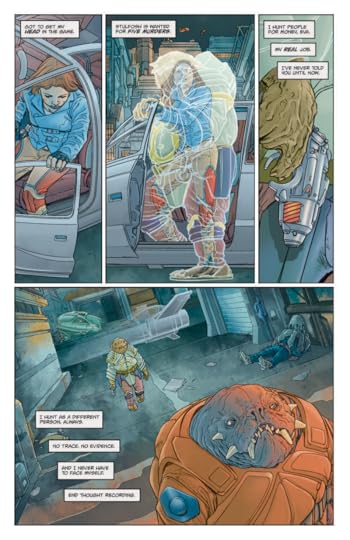On Comics: Satellite Falling #1 from IDW

I've been out of the comic book reviewing game for the last few months. This is for a lot of reasons that I won't go into at the moment, but when series writer Steve Horton approached me on Twitter about reviewing his new comic Satellite Falling #1 (out from IDW Publishing as of May 11th), I decided it might be a nice excuse to do some writing.
Written by Steve Horton (Amala's Blade), illustrated by Stephen Thompson (Star Trek, Brooklyn Animal Control), and with colors by Lisa Jackson (Angel), the best way to describe Satellite Falling is a sci-fi detective story with some punch and a lot of potential. It follows Lily, a jaded human bounty on an alien world where she's the only one of her kind. Using gadgets to disguise herself as one of the many alien races she encounters, she goes on undercover operations and tracks down criminals in suitably dingy futuristic locales. All of this, along with a reasonable amount of extraterrestrial sexy times, is to cover up her ongoing grief over the loss of her girlfriend, Eva. While Eva's fate is unknown as of the first issue, it is assumed to be appropriately tragic, which provides the context for Lily's narration, addressed to Eva in the form of a recorded message.

Art by Stephen Thompson and Lisa Jackson
The book knows its noir conventions, even as it dresses them up in a shinier, sci-fi/fantasy aesthetic. Loss, regret, memory -- familiar themes splashed against a canvas populated with bizarre alien bodies and sloping, metallic architecture. Horton's script drips with hard-boiled swagger, with nods to Rick Deckard of Blade Runner in both Lily's attitude and profession. It tickles the part of my brain that always lights up for pulpy dialogue. The plot, heavy on set-up given that this is a #1, is predictable, but contains enough fun twists and subversions of standard detective tropes to give it some flair.
Thompson's artwork, with Jackson's color palettes, are the main attraction to this title. The linework is clean and light overall. Jackson consciously undermines the gritty tone of the world and its characters with bright, vibrant coloring. Soft hues of blue and pink lull the reader into a somber state as Lily's narration carries the first third of the three-act book, before shifting to the deeper, bolder color choices in plot- or action-heavy sequences. It creates somewhat of a jarring tonal shift for me personally toward the end of the issue, but given how it reflects the action on the page, I appreciate the implementation and effect.
Thompson's complex exterior architecture and cityscapes affect rounded, organic shapes, which stand apart from the sterile vertical planes of interior spaces. Beneath the glittering chrome of the skyscrapers lurks the grubby underbelly of the urban spaces where Lily traverses. Here the cracks in the shiny science fiction veneer give way to the crime story driving the plot, grounding both elements in a tidy shorthand. Everything in the book is a negotiation, from the aesthetics to the tone, actively seeking balance with the other elements. It's neither too gritty nor too upbeat, too hard nor too soft. I found myself paying attention to the details in every panel, caught by the casual juxtaposition between seemingly competing visual and tonal styles.

Art by Stephen Thompson and Lisa Jackson
The character designs achieve a similar contrast. The alien creatures are wildly diverse and wonderfully detailed, with all manners of eyes, mouths, pincers, fleshy ridges, and tentacles. This biomorphic variety makes Lily look remarkably small, fragile, and alien in relation. Although she is the most familiar creature we see (not taking into account the walrus-like criminal she encounters in the book's opening), she looks the most foreign, lonely and lost.
Even without Lily's mournful narration, we see how profoundly alone she is. It makes what little intimacy we see her enjoy in this issue all the more meaningful and less paint-by-numbers. Yes, Eva haunts her memories in ghosting touches, and yes, there's a somewhat obligatory (albeit potentially emotionally complicated) sex scene, but the visual context provides a little more depth than I often see in stories about humans on strange worlds.
Satellite Falling #1 plays with many familiar themes and genre conventions, but it pulls them all together well for an opening issue. It's pulpy, sci-fi fun with some genuinely interesting concepts and storytelling decisions that I appreciated. The book definitely has potential, and I'm curious to see where it goes in coming issues. If you like all things spacey, pulpy, and full of goopy aliens, I recommend picking it up.



